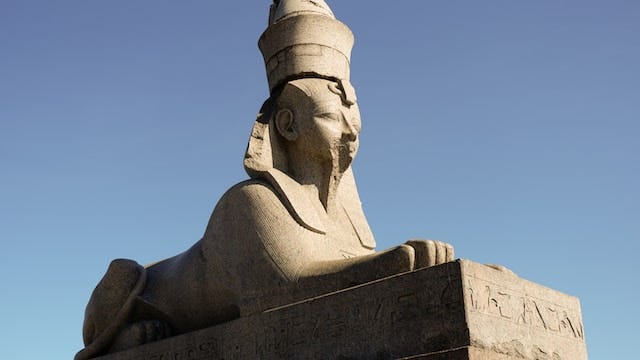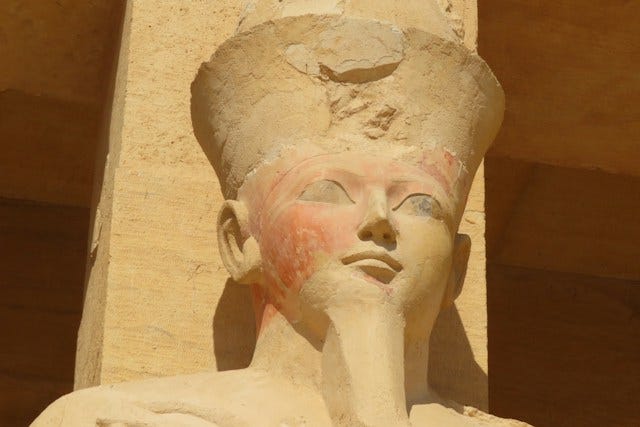Black Women are Amazing: Hatshepsut
A Woman's Touch

Manifesting and creating a new reality for your self has largely to do with how well you can combine your will, your emotions and your ability to visualize. It is the feminine side of our being that we most use to achieve this, and those that are more in touch with it are able to create and manifest in a way that appears to be effortless.
Relying heavily on my masculine mind has limited me. I need to use my feminine mind more and to strengthen it. Paying close attention to my feminine qualities, and understanding that women access the feminine mind more often and easier than men, has convinced me to try to learn more about how certain women used, what I would call, divine wisdom to achieve greatness.
First, I want all of you to know that we are comprised of masculine and feminine qualities or principles:
“Gender is in everything; everything has its Masculine and Feminine Principles; Gender manifests on all planes.” - Kybalion
This is the principle of gender and one of the seven laws governing our universe.
In his book, Ancient Future, Wayne B. Chandler explains that, “…the terms masculine and feminine do not correspond one-to-one with the terms man and woman since, by the Law of Polarity, masculine and feminine are not necessarily opposites, but simply the two shades of gender. If gender is conceptualized as a scale, the poles of which are pure maleness and pure femaleness, then we can see how we have come to label people male or female. Those who are psychologically and physically closer to the male pole are called men, while those who are closer to the female pole are called women. Though many of us choose to view this scale as fixed or steadfast, our present social, cultural, as well as psychological, circumstances dictate a broader reality, informing us of potentiality of more than two types of sexes. It is gender, operating within the parameters of polarity, that makes this a possibility.”1
Furthermore, “Gender, apart from its modern association with sex, is the process of begetting, generating, creating, and producing on all planes of creation.”2
There is plenty talk in the world about manifesting via the law of attraction and using visualization, but what is not mentioned is that it takes the feminine part of our being to visualize and it takes the union of our masculine and feminine energies to achieve our desired manifestation. And what is also not mentioned is gender and that at its root the word expresses generating and creating, as mentioned above. The masculine mind cannot harness unconditional love, but unconditional love is essential in the creation process. We of male-dominated culture and society have been conditioned to overlook the feminine. Wayne tells us, “This forced exclusion of the feminine aspect of creation has wreaked havoc on virtually every individual psyche in all Western and Western-influenced cultures and civilizations.”3 What I found particularly interesting is that Wayne mentions we have replaced mother with matter. My interpretation in this regard is - we have replaced Mother Earth with a shadow of herself. We must take the first step back to ancient wisdom, divine wisdom, by observing it and recognizing where it has been and where it continues to appear.
This brings me to Hatshepsut, and her very significant impact on society both physically and spiritually. One of the greatest rulers of antiquity, Hatshepsut was of southern Egyptian ancestry, a region mixed with indigenous Sudanese Africans. Her grandmother, Nefertari-Aahmes, was Ethiopian and carried a rich dark skin complexion.
Although Hatshepsut’s mummy has not been found, it is clear that she is the granddaughter of Ahmose and Ahmose-Nefertari [Nefertari-Aahmes] and the daughter of Thutmoses I and Mutnofret. From this one can readily infer that she, too, in Hansberry’s words, “was neither a blond nor a brunette but rather a person who was in all likelihood either dark-brown or black.”4
I think it’s important whenever we can to acknowledge indigenous origins and the strength of indigenous people. Hatshepsut clearly exudes this strength and pays homage to her ancestry as seen in her rise to power and rulership within the Egyptian dynasty of the day.
If you think Y&R has drama or any other soap opera for that matter, think again! Her (half) brothers5, Thotmes II and Thotmes III, rivalled against her for the throne. And with the latter successfully staging a trick to sway the people to his side, Hatshepsut was forced into a compromise resulting in marriage to Thotmes III. But this was only the beginning of a bitterly fought power struggle, one filled with craftiness and strategy.
When we next find Hatshepsut in historical records, “… by skilful intrigues she not only restores herself as co-ruler but finally thrusts him [Thotmes III] into the background as a mere husband, who is inferior to her prime minister, Nehusi, which name in Egyptian means “full-blooded Negro6”.”7
Then came the attacks from the priests of Amen, who claimed she was not of pure lineage, because her father was not of pure Theban stock; therefore she was not worthy of the throne. But she brilliantly out manoeuvred her adversaries once again. In the realm of politics, gaining the favour of the people results in gaining influence and power. This is exactly what Hatshepsut set out to do, and in those days there was no better way than through the construction of great temples, pyramids and other breath taking monuments. To the populace this would be evidence enough of a ruler’s great power and authority.
And so she began building, starting with her great temple. It stood on elevated ground hence overshadowing her opponents. She then ordered two obelisks, taller than any others throughout the land. Hewn from blocks of rose granite, it took two massive rafts each manned by 900 men, to transport the obelisks down the river Nile. They were gifts for none other than her detractors, the priests of Amen, and to be erected in their Temple of Amen-Ra. But here’s the catch, she very astutely ordered the obelisk to be taller than the temple they were to sit in. She knew the roof of the temple would have to be removed. Accordingly, Hatshepsut had the heads of the obelisks encased in electrum, a metal alloy of silver and gold. The result: these obelisks shone with the brilliancy of a twin star, and could be seen across Egypt as a symbol of Hatshepsut’s power and rulership.
But it didn’t end there. When gender prejudice reared its ugly head once again, she boldly announced that she was really a man – stuck a false beard to her chin, and adorned herself in male garments. (It doesn’t get any better than this.) It was a strategy that crushed all further opposition and was sealed by changing her name from the original Hatshepsitu to the now commonly known Hatshepsut, which is the male version of the name. She asserted she was immaculately conceived of a virgin birth and that the great god Amen himself had appeared to her mother “in a flood of light and perfume.” (This translates to: challenge me and you die.)
Hatshepsut ruled for 33 years and in all this time she stayed true to her inner calling, refusing to be overcome by fear and doubt. What one person perceives as a dead end or an impossibility, this women took as motivation. This is how you will face adversity. Ask yourself this question: where did Hatshepsut’s astuteness, wisdom and strategy come from? And then go to the same Source of truth and guidance and continue to persevere along your life journey.
There is no doubt of the large impact Hatshepsut had on society both physically with her mega structures, and spiritually as she transcending gender walls. Her spirit of triumph is a spirit that resides in you, only if you allow it. By remembering our African queen and Pharaoh Hatshepsut, she remains immortalized. Although her tomb was discovered in the Valley of the Kings, where only the lordly males were buried (the queens had their own burial place), she lives on beyond the walls she teared down.
The boundaries that others will try to erected before you, can only exist if you allow them. In reality, no boundary can stand without your permission, whether its origins are from society or from within your being. Spend some time and dwell on this, and on the expression of wisdom we today call woman.
p. 97, Ancient Future by Wayne B. Chandler
Ibid., p. 100
Ibid., p. 101
Black Rulers of the Golden Age by Legrand H. Clegg II, p. 249, in Egypt Revisited (editor Ivan Van Sertima)
In African culture there is no term half brother or half sister. All are brothers and sisters.
The term ‘Negro’ is no longer used and is seen as unacceptable in reference to indigenous African people. However, at the time of the translation of the word ‘Nehusi’ it was in use.
Taken from The World’s Great Men of Color, Vol. 1, by J.A. Rogers


